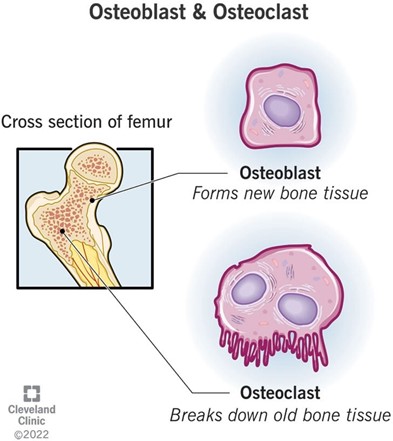Which type of cell is responsible for breaking down bone tissue?
Osteoclast.
Chondrocytes.
Osteocytes.
Osteoblast.
The Correct Answer is A
Osteoclasts are the type of cells that break down bone tissue by secreting acid and enzymes.
They are derived from monocytes and macrophages, two types of white blood cells.

Choice B is incorrect because chondrocytes are the cells that produce and maintain cartilage, a flexible connective tissue found in joints.
Choice C is incorrect because osteocytes are the mature bone cells that maintain the mineral concentration of the bone matrix.
They are derived from osteoblasts, the bone-forming cells.
Choice D is incorrect because osteoblasts are the cells that form new bone by synthesizing and secreting collagen and calcium salts.
They are derived from osteogenic cells, the undifferentiated cells that can divide.
Nursing Test Bank
Naxlex Comprehensive Predictor Exams
Related Questions
Correct Answer is B
Explanation
The acromioclavicular joint is the articulation between the acromion of the scapula and the acromial end of the clavicle.
It is a plane synovial joint that allows movements of the shoulder girdle. Choice A is incorrect because the ulna and scapula do not form a joint.
The ulna is a bone of the forearm that articulates with the humerus and radius. Choice C is incorrect because none is not a valid option.
There is a specific joint between two bones that is called the acromioclavicular joint.
Choice D is incorrect because the humerus and scapula form a different joint, called the glenohumeral joint.
This is a ball-and-socket synovial joint that allows movements of the shoulder.
Correct Answer is A
Explanation
Osteoclasts are the type of cells that break down bone tissue by secreting acid and enzymes.
They are derived from monocytes and macrophages, two types of white blood cells.

Choice B is incorrect because chondrocytes are the cells that produce and maintain cartilage, a flexible connective tissue found in joints.
Choice C is incorrect because osteocytes are the mature bone cells that maintain the mineral concentration of the bone matrix.
They are derived from osteoblasts, the bone-forming cells.
Choice D is incorrect because osteoblasts are the cells that form new bone by synthesizing and secreting collagen and calcium salts.
They are derived from osteogenic cells, the undifferentiated cells that can divide.
Whether you are a student looking to ace your exams or a practicing nurse seeking to enhance your expertise , our nursing education contents will empower you with the confidence and competence to make a difference in the lives of patients and become a respected leader in the healthcare field.
Visit Naxlex, invest in your future and unlock endless possibilities with our unparalleled nursing education contents today
Report Wrong Answer on the Current Question
Do you disagree with the answer? If yes, what is your expected answer? Explain.
Kindly be descriptive with the issue you are facing.
